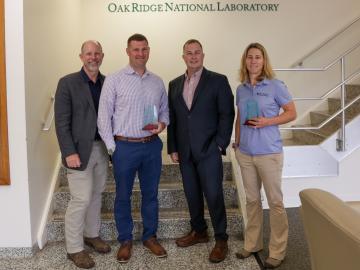
Filter News
Area of Research
- (-) Energy Science (108)
- (-) Fusion Energy (2)
- (-) National Security (48)
- Advanced Manufacturing (5)
- Biology and Environment (60)
- Building Technologies (2)
- Computational Biology (1)
- Computational Engineering (3)
- Computer Science (15)
- Electricity and Smart Grid (1)
- Energy Sciences (1)
- Fuel Cycle Science and Technology (1)
- Functional Materials for Energy (1)
- Fusion and Fission (6)
- Isotopes (2)
- Materials (46)
- Materials for Computing (17)
- Mathematics (1)
- Neutron Science (24)
- Nuclear Science and Technology (3)
- Quantum information Science (7)
- Supercomputing (130)
News Topics
- (-) Computer Science (43)
- (-) Coronavirus (14)
- (-) Frontier (3)
- (-) Mathematics (2)
- (-) National Security (37)
- (-) Polymers (11)
- 3-D Printing/Advanced Manufacturing (82)
- Advanced Reactors (14)
- Artificial Intelligence (19)
- Big Data (11)
- Bioenergy (28)
- Biology (14)
- Biomedical (7)
- Biotechnology (5)
- Buildings (38)
- Chemical Sciences (14)
- Clean Water (8)
- Composites (17)
- Critical Materials (9)
- Cybersecurity (25)
- Energy Storage (71)
- Environment (59)
- Exascale Computing (2)
- Fossil Energy (2)
- Fusion (17)
- Grid (43)
- High-Performance Computing (10)
- Hydropower (3)
- Isotopes (1)
- Machine Learning (18)
- Materials (37)
- Materials Science (31)
- Mercury (3)
- Microelectronics (1)
- Microscopy (8)
- Molten Salt (1)
- Nanotechnology (9)
- Neutron Science (15)
- Nuclear Energy (21)
- Partnerships (16)
- Physics (2)
- Quantum Science (3)
- Security (15)
- Simulation (4)
- Space Exploration (3)
- Statistics (1)
- Summit (7)
- Transportation (68)
Media Contacts

Cameras see the world differently than humans. Resolution, equipment, lighting, distance and atmospheric conditions can impact how a person interprets objects on a photo.

When the COVID-19 pandemic stunned the world in 2020, researchers at ORNL wondered how they could extend their support and help

Oak Ridge National Laboratory’s Innovation Crossroads program welcomes six new science and technology innovators from across the United States to the sixth cohort.

Mechanical engineer Marm Dixit’s work is all about getting electricity to flow efficiently from one end of a solid-state battery to the other. It’s a high-stakes problem

Though Nell Barber wasn’t sure what her future held after graduating with a bachelor’s degree in psychology, she now uses her interest in human behavior to design systems that leverage machine learning algorithms to identify faces in a crowd.

In front of family and friends, Lt. Col. Jessica Critcher and Maj. Micah McCracken gave their final report on their eye-opening year as ORNL military fellows.

Scientists develop environmental justice lens to identify neighborhoods vulnerable to climate change
A new capability to identify urban neighborhoods, down to the block and building level, that are most vulnerable to climate change could help ensure that mitigation and resilience programs reach the people who need them the most.

ORNL scientists will present new technologies available for licensing during the annual Technology Innovation Showcase. The event is 9 a.m. to 3 p.m. Thursday, June 16, at the Manufacturing Demonstration Facility at ORNL’s Hardin Valley campus.

It’s a simple premise: To truly improve the health, safety, and security of human beings, you must first understand where those individuals are.

What’s getting Jim Szybist fired up these days? It’s the opportunity to apply his years of alternative fuel combustion and thermodynamics research to the challenge of cleaning up the hard-to-decarbonize, heavy-duty mobility sector — from airplanes to locomotives to ships and massive farm combines.


